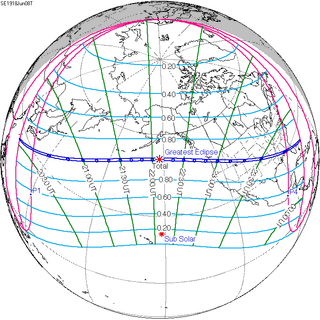
Back Сонечнае зацьменне 8 чэрвеня 1918 года Byelorussian خورشیدگرفتگی ۸ ژوئن ۱۹۱۸ Persian Eclissi solare dell'8 giugno 1918 Italian 1918年6月8日の日食 Japanese 1918년 6월 8일 일식 Korean Zonsverduistering van 8 juni 1918 Dutch 1918年6月8日日食 Chinese 1918 nî 6 goe̍h 8 ji̍t sit-ji̍t ZH-MIN-NAN
| Solar eclipse of June 8, 1918 | |
|---|---|
| Type of eclipse | |
| Nature | Total |
| Gamma | 0.4658 |
| Magnitude | 1.0292 |
| Maximum eclipse | |
| Duration | 143 s (2 min 23 s) |
| Coordinates | 50°54′N 152°00′W / 50.9°N 152°W |
| Max. width of band | 112 km (70 mi) |
| Times (UTC) | |
| Greatest eclipse | 22:07:43 |
| References | |
| Saros | 126 (42 of 72) |
| Catalog # (SE5000) | 9324 |
A total solar eclipse occurred at the Moon's descending node of orbit between Saturday, June 8 and Sunday, June 9, 1918,[1] with a magnitude of 1.0292. A solar eclipse occurs when the Moon passes between Earth and the Sun, thereby totally or partly obscuring the image of the Sun for a viewer on Earth. A total solar eclipse occurs when the Moon's apparent diameter is larger than the Sun's, blocking all direct sunlight, turning day into darkness. Totality occurs in a narrow path across Earth's surface, with the partial solar eclipse visible over a surrounding region thousands of kilometres wide. Occurring 3.7 days after perigee (on June 5, 1918, at 8:40 UTC), the Moon's apparent diameter was larger.[2]
The eclipse was viewable across the entire contiguous United States, an event which would not occur again until the solar eclipse of August 21, 2017.
- ^ "June 8–9, 1918 Total Solar Eclipse". timeanddate. Retrieved 1 August 2024.
- ^ "Moon Distances for London, United Kingdom, England". timeanddate. Retrieved 1 August 2024.
